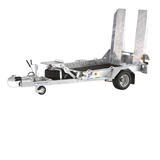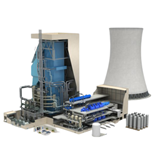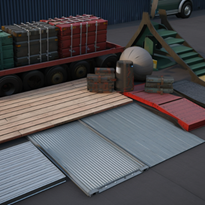Container ramps are essential for loading and unloading heavy items from shipping containers, trucks, or warehouses. They offer safety and efficiency in various industries, from construction and logistics to agriculture and manufacturing. In this guide, we will walk you through everything you need to know when purchasing a container ramp.
Types of Container Ramps: Choosing the Right One for Your Business
Container ramps are essential for businesses that need to move heavy cargo in and out of shipping containers. They come in different types, each designed to meet specific needs. Choosing the right container ramp for your business can improve efficiency and safety while reducing downtime and damage to goods.
Here are the different types of container ramps and how to choose the right one for your business:
-
Stationary container ramps
Stationary ramps are fixed in one location, and they are suitable for businesses that have a permanent loading and unloading area. They are durable, require little maintenance, and can support heavy loads. However, they cannot be moved, and they may not be suitable for businesses that need to load and unload cargo in different locations.
-
Portable container ramps
Portable ramps are designed to be moved from one location to another. They are lightweight, easy to install, and can be used on uneven surfaces. They are ideal for businesses that need to load and unload cargo in different locations. However, they may not be as durable as stationary ramps, and they may require more maintenance.
-
Forklift container ramps
Forklift ramps are designed to be used with a forklift to move heavy cargo in and out of shipping containers. They are usually made of steel and have a non-slip surface to prevent accidents. They are suitable for businesses that have a forklift and need to move heavy cargo regularly. However, they may not be suitable for businesses that do not have a forklift.
-
Adjustable container ramps
Adjustable ramps are designed to be adjusted to different heights, making them suitable for businesses that need to load and unload cargo from containers of different heights. They are usually made of steel and can support heavy loads. They are ideal for businesses that need to move cargo in and out of shipping containers of different sizes.
5 Factors to Consider When Choosing a Container Ramp
When choosing a container ramp, there are several factors that you should consider to ensure that it meets your specific needs. Here are five key factors to consider when selecting a container ramp:
-
Load Capacity: The load capacity of the ramp should be able to support the weight of the heaviest cargo that you need to load or unload. This is especially important for businesses that deal with heavy cargo such as construction materials or heavy equipment.
-
Ramp Height: The height of the ramp should be compatible with the height of the container that you will be loading or unloading. Make sure to measure the height of your containers to ensure that the ramp will be able to reach the desired height.
-
Durability: The ramp should be durable and able to withstand heavy use and harsh conditions. Look for ramps that are made of high-quality materials, such as steel, that can resist wear and tear over time.
-
Portability: If your business requires you to move the ramp to different locations frequently, you may want to consider a portable ramp that can be easily moved. Portable ramps are often lightweight and foldable, making them easy to transport.
-
Safety Features: Safety should be a top priority when choosing a container ramp. Look for ramps with non-slip surfaces, safety chains, and other safety features that can prevent accidents and injuries. It is also important to ensure that the ramp is designed to prevent cargo from slipping or sliding during loading or unloading.
Why Your Business Needs a Container Ramp
If your business regularly deals with shipping containers, a container ramp can be a valuable investment. Here are some reasons why your business needs a container ramp:
-
Increased Efficiency: A container ramp can significantly increase the efficiency of loading and unloading cargo from shipping containers. It provides a safe and easy way to move heavy or bulky items in and out of the containers, reducing the time and effort needed to load or unload.
-
Improved Safety: Using a container ramp can help reduce the risk of accidents and injuries during loading and unloading. It provides a stable surface for workers to walk on, reducing the likelihood of slips and falls. It can also prevent cargo from shifting or falling during loading and unloading, reducing the risk of injuries or damage to goods.
-
Versatility: Container ramps come in various types and sizes, making them adaptable to different business needs. Whether you need a stationary ramp for a permanent loading area, a portable ramp for use in different locations, or an adjustable ramp to accommodate different container heights, there is a ramp that can meet your specific needs.
-
Cost-Effective: Investing in a container ramp can be a cost-effective solution compared to hiring equipment or manpower to load and unload cargo. It can also reduce the likelihood of damage to goods or equipment, which can save on repair or replacement costs in the long run.
-
Increased Productivity: By reducing the time and effort needed to load and unload cargo, a container ramp can increase productivity and throughput for your business. This can translate into increased profitability, as more cargo can be moved in less time.
What to consider when purchasing a loading ramp for plant and machinery
When purchasing a loading ramp for plant and machinery, there are several important factors to consider to ensure that you choose the right ramp for your specific needs. Here are some key considerations:
-
Weight capacity: It is essential to choose a loading ramp with the appropriate weight capacity for the equipment or machinery that you need to load. Check the manufacturer's specifications for your machinery to determine the weight limit and choose a ramp with a weight capacity that exceeds that limit.
-
Ramp length: The ramp length will determine the angle of the ramp and the ease with which the machinery can be loaded. A longer ramp will provide a shallower angle, making it easier to load equipment that has low ground clearance. Conversely, a shorter ramp will provide a steeper angle, which may be suitable for loading equipment with higher ground clearance.
-
Ramp width: Ensure that the ramp is wide enough to accommodate the machinery or equipment that you need to load. Consider the width of the equipment's tires or tracks and add some extra clearance for safety.
-
Surface material: The surface material of the ramp can have a significant impact on safety and ease of loading. Look for a ramp with a non-slip surface, such as punched steel, to prevent accidents and ensure that machinery can be loaded and unloaded safely.
-
Portability: Depending on your business needs, you may need a loading ramp that can be easily moved from one location to another. Consider the weight and portability of the ramp, as well as any accessories such as handles or wheels that can make it easier to move.
-
Safety features: Look for safety features such as guardrails, safety chains, or non-slip surfaces that can help prevent accidents and protect workers during loading and unloading.
The Advantages of Aluminium Container Ramps
Aluminium container ramps are a popular choice for businesses that need to load and unload cargo from shipping containers. Here are some advantages of aluminium container ramps:
-
Lightweight: Aluminum is a lightweight material, making aluminium container ramps easy to move and install. This is especially important for businesses that need to use the ramps in different locations.
-
Corrosion-resistant: Aluminum is highly resistant to corrosion, making it an ideal material for use in humid or damp environments, such as near the sea or in areas with high rainfall.
-
Durable: Although aluminium is lightweight, it is also strong and durable. Aluminium container ramps can withstand heavy loads and harsh conditions, making them a reliable choice for businesses that need to move heavy cargo.
-
Easy to clean: Aluminum is easy to clean and maintain, which can help to reduce maintenance costs and downtime.
-
Non-slip surface: Aluminum container ramps can be designed with a non-slip surface, which can help to prevent accidents and ensure worker safety during loading and unloading.
-
Recyclable: Aluminum is a highly recyclable material, making aluminium container ramps an environmentally friendly choice.
-
Cost-effective: Aluminum container ramps are cost-effective, as they can last for many years with minimal maintenance. They are also a more affordable option compared to other materials, such as steel.
Hydraulic Container Ramps: Benefits and Applications
Hydraulic container ramps are a type of loading ramp that uses hydraulic cylinders to lift and lower the ramp. They are commonly used in businesses that need to load and unload heavy cargo from shipping containers. Here are some benefits and applications of hydraulic container ramps:
Benefits:
-
Easy to operate: Hydraulic container ramps can be easily operated with a simple button or lever, making them user-friendly and efficient.
-
Quick loading and unloading: Hydraulic container ramps can be raised and lowered quickly, reducing the time needed for loading and unloading cargo.
-
Safe: Hydraulic container ramps have safety features such as non-slip surfaces, safety chains, and guardrails to prevent accidents and injuries during loading and unloading.
-
Customizable: Hydraulic container ramps can be customized to fit the specific needs of your business. They can be made in different sizes and weight capacities to accommodate various types of cargo.
-
Durable: Hydraulic container ramps are built to last and can withstand heavy use and harsh environments.
Applications:
-
Manufacturing: Hydraulic container ramps can be used to load and unload heavy machinery or equipment in manufacturing plants.
-
Warehousing: Hydraulic container ramps can be used to load and unload pallets of goods in warehouses.
-
Construction: Hydraulic container ramps can be used to move construction equipment and materials on and off construction sites.
-
Freight forwarding: Hydraulic container ramps can be used in freight forwarding businesses to load and unload cargo from shipping containers.
-
Retail: Hydraulic container ramps can be used in retail businesses to load and unload large shipments of goods.
Container ramps are essential for loading and unloading heavy items from shipping containers, trucks, or warehouses. There are different types of container ramps, including stationary, portable, forklift, and adjustable ramps. Choosing the right ramp for your business depends on various factors such as load capacity, ramp height, durability, portability, and safety features.
Investing in a container ramp can increase efficiency, improve safety, provide versatility, and be cost-effective for your business. When purchasing a loading ramp for plant and machinery, it's crucial to consider weight capacity, ramp length, ramp width, surface material, portability, and safety features.

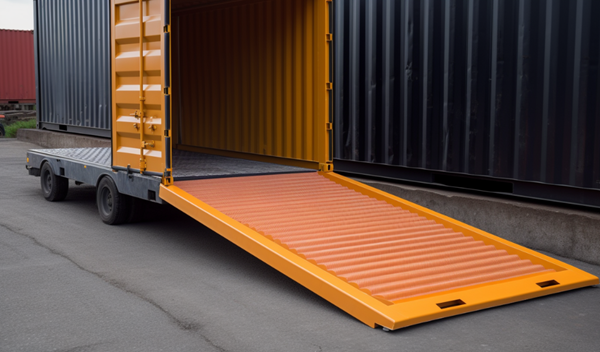



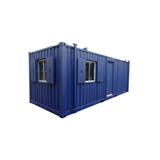

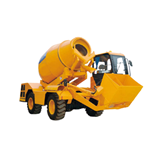


-160x160-state_article-rel-cat.png)

-160x160-state_article-rel-cat.png)




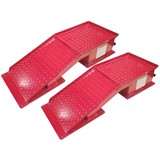
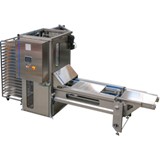
-160x160-state_article-rel-cat.png)


